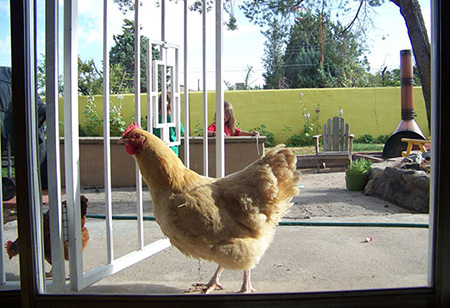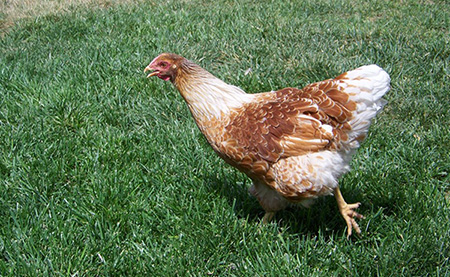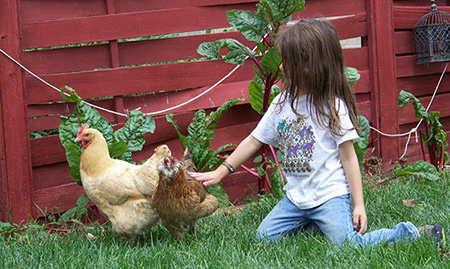
I knew I wanted a coop and flock the very first time I read about Albuquerque’s zoning codes for poultry. For most of the city, this policy equates to “don’t have a rooster, thanks”— making residents of central New Mexico luckier than suburban dwellers in many an elsewhere, where residents battle city codes prohibiting even the smallest farm animals.
After researching chicken needs from housing to food to healthcare, I felt our family was primed to become excellent suburban poultry farmers. I went to the Albuquerque Coop and Garden Tour, strutting as I walked around each yard, “I got this.” Then, I could already hear their gentle clucks of my future feathery pets as my husband and I built our coop and run. The habitat setup turned out to be a hair shabbier than the shabby-chic chicken-French-cottages in my favorite urban farm blogs, despite the sweat and hammered thumbs we poured into the wood-and-wire colossus. Looking back, this was the first sign of how chicken-keeping was to turn out for us: always a little dirtier, stranger, and more complex than I imagined.
Now, one year into our small-time homesteading, I feel confident in saying I prepared well for our birds’ needs. Unfortunately, I also feel confident in saying I prepared poorly for our own needs, specifically for ensuring poultry-keeping would be easy and manageable. I triple checked that our birds would be healthy and happy while I zero-checked our human equivalencies.
Overall, the chicken keeping adventure has been worthwhile with many payoffs, but here are aspects I wish I’d considered before laying our coop’s foundation:
Hens are loud.
Most people think the urban-rooster ban is to spare neighborhoods all that pre-dawn and pre-dusk crowing. Hens are supposed to be the quiet ones. Understand, then, the absolute horror with which I observed on the first morning of chicken-ownership, our hens squawking like macaws at 5:30 AM. Our poor neighbors! I resolved to get up at the crack of dawn to let the chickens free range, which generally quiets them. However, the earlier I got up to let the chickens roam, the earlier they insisted to be let out. Then they began squawking all day at the door of their run, which was twice the size my chicken-keeping guides claimed would keep a small flock happy. The more I let the hens roam, the more they couldn’t stand the injustice of the coop.
Lessons:
1. Roosters crow twice a day. Hens squawk all day long, especially when laying.
2. I should have built the coop further from our neighbor’s house and the window of our toddler.
3. Different breeds have different noise expectations.
4. Chickens learn. If you let chickens boss you, they will boss you.
Eggs: They break.
“Collect eggs often” was mentioned in my pre-chicken-keeping research, but what it should have said was “Collect eggs immediately.” Chickens will eat their eggs if broken, and this can quickly lead to chickens breaking their eggs on purpose. If you are like most urban or suburban chicken keepers, you probably have a job; one of the big draws toward chicken keeping is lower time commitment compared to other small-space homesteading options. However, working away from home can be a recipe for creating egg-eating chickens if you can’t check the nests often enough.
There are lots of work-arounds, like having extra nest boxes, but it’s no guarantee. Despite their extra nest boxes, my hens refuse to lay in any but the one “popular box.”
Lesson: Hens will give you complex issues, such as societal norms over which nest box to lay in affecting how often to collect eggs.
Hens will eat your beautiful garden in 30 seconds flat.
My chicken keeping books warned me that hens would eat plants in my garden if they were “not established.” Fact check: hens will eat anything from about 1’ over their heads to 6” under the ground. They are like a plague of locust-moles.
Lesson: Fence in anything you don’t want eaten, pooped on, or dug up.

Hens need a lot of water.
These five small birds need a handful of chicken feed every day. Imagine my surprise, then, that they need their 5 gallon water tank filled up every day, sometimes twice a day. Some of this is due to good old New Mexico evaporation. Some of it due to the birds trying to perch on the tank, knocking out a few cups several times a day. Some of it is due to the fact that when they perch on the water tank, they park their rears right over the drinking area and therefore the whole tank needs to be cleaned out. A very little bit of it is because the chickens drink the water.
When we built the coop out of range of a hose, it seemed like no big deal to simply take the water tank over to the hose. As it turns out, the tank is monstrously heavy when completely filled, and needs to be filled daily.
Lesson: Build your coop a very convenient distance from water. A hose reaching any corner of the coop would be fantastic.
Hens will quickly associate you with food.
The pastoral ideal in my mind, when I embarked on raising poultry, was pitifully based on the images in urban farm magazines and do-it-all family blogs. In such photographs, chickens free-range happily in the yard while their humans work in the garden, drink tea under a pagoda, or entertain others in my market segment. Perhaps I would have been more successful if I had a pagoda, but none of these images were to come true.
My chickens learned quickly that I was the face of food, sweet food. When I open the door to go outside, they run at me like fluffy rugby players. Then they hustle under my feet, examining me with those dinosaur-eyes and squawking that squawk we’ve already talked about. For the entirety of my time outside. It’s really unnerving.
Lesson: I don’t know what to do about this one. They freak me out a little.

Still happy with our micro farm.
All things considered, I still believe keeping hens has been a great experience for our family-- and, as long as we don’t have jobs or lives, we get eggs out of the deal, too! All kidding aside, much of the benefit of keeping these birds has been outside of our expectations. This last year we’ve gained:
- A better understanding of the complex, intensive raising of a “natural” animal product versus industrial production methods.
- The experience of growing food on a very small space. When we were buying our home, we looked at some big properties where we dreamed of big gardening and big animal husbandry. This has been a great way to test the waters. It’s been rewarding to see how much we can supplement our food needs even on a small city lot like ours.
- Free, fast compost from veggie leftovers that used to take months to break down in the compost bin. We’ve tried several types of composting and the chickens absolutely get organic matter ready to go back into the ground the fastest. Unlike most large animal manure, chicken manure does not need an extended time to rot before use as compost or fertilizer.
- Best of all, our children have hands-on experience caring for farm animals with complex needs and life cycles. They understand where animal foods come from and how to have a symbiotic relationship with animals.



Responses to “Small-scale chicken-keeping in New Mexico”